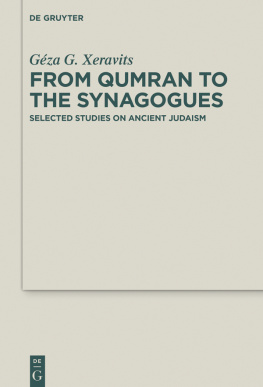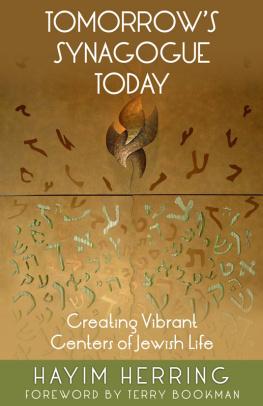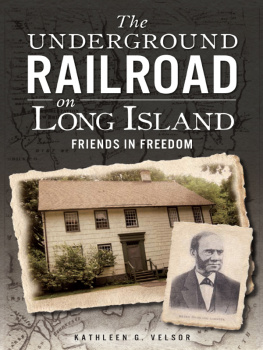Published by The History Press
Charleston, SC
www.historypress.net
Copyright 2017 by Ira Poliakoff
All rights reserved
First published 2017
e-book edition 2017
: Prayer recited by all Jews at all services. Courtesy of Ira A. and Judith L. Poliakoff.
ISBN 978.1.43966.349.3
Library of Congress Control Number: 2017953974
print edition ISBN 978.1.46713.836.9
Notice: The information in this book is true and complete to the best of our knowledge. It is offered without guarantee on the part of the author or The History Press. The author and The History Press disclaim all liability in connection with the use of this book.
All rights reserved. No part of this book may be reproduced or transmitted in any form whatsoever without prior written permission from the publisher except in the case of brief quotations embodied in critical articles and reviews.
PREFACE
Reform and Conservative congregations have often disagreed on how to practice Judaism, how to pray and what to offer their members. The philosophical differences between Reform and Conservative congregations and their Orthodox neighbors have not been so subtle. Many Orthodox look at Reform and Conservative congregations as non-entities because, in their belief, only the Orthodox follow true Judaism.
In the late 1970s, the established Reform and Conservative congregations of Nassau and Suffolk faced three impactful changes. The first was a tremendous demographic shift. Inner-ring suburbs that had been filled with Jewish families were now filling with the next series of new immigrants. The suburban enclaves on the eastern half of Long Island, which had no real Jewish population to speak of in the 1950s, were now starting to develop Jewish populations. Villages like the Hamptons, which had only a few Jews as summer residents, now were home to several synagogues. Villages like Rockville Centre, Baldwin and Freeport saw their Jewish populations drop more than 50 percent.
The second change was the outreach program of the Chabad Lubavitch, a movement from within Judaism. Chabad has always accepted the role to minister to anyone interested in the Jewish faith, but in the late 1980s, many young Chabad rabbis were sent to different towns on Long Island with nothing other than a loving rebbetzin and a checkbook. To date, they have opened more than thirty Chabad centers in Nassau and Suffolk Counties, each staffed by at least one rabbi and rebbetzin. Chabad maintains a central office for Long Island in Commack.
Many Reform and Conservative congregations claim to have lost some members to the Chabad movement. Some can be explained by personal epiphanies moving the members to Orthodoxy. Some leaders have told me that some of their members have left the Reform and Conservative synagogues because there is no specific financial commitment needed for a family to affiliate with a Chabad center. It is indeed wonderful that Chabad centers accept anyone for any period and are willing to invest in a familys religious education and well-being, but some believe that it is partially at the expense of bricks and mortar synagogues.
The third major impact was the advent of the mobile society. Parents were used to sending their college-bound teens to local colleges. Many followed family traditions by attending branches of CCNY or SUNY. Some went to Hofstra, Post or Adelphi. Starting in the 1970s, going away to Ann Arbor, Michigan, or Atlanta, Georgia, was just as easy as going to Albany for college. Many students left for these places never to return, spreading out Long Islands Jewish population nationwide.
Rabbi Neil S. Cooper of Temple Beth HillelBeth El of Wynnewood, Pennsylvania, an inner-ring suburb of Philadelphia, has spent more than twenty-five years facing these same problems. His is one of fourteen congregations within a ten-square-mile area, including two Reform, four Conservative, two Chabad and eight other Orthodox. His synagogue has managed to keep its numbers over the years and, in some years, even increase them. His answer is rather simple: We work hard at it. He and his colleagues offer myriad complex programs aimed at all arms and age groups of his community. A recent event attended by more than two hundred congregants took more than thirty professionals and lay leaders weeks to plan. Those congregations that have worked extremely hard at programming for and attracting all spheres of membership are going to be the ones to survive. Elisa Blank, Long Island coordinator for the Synergy Project, a synagogue coaching project sponsored by UJA/Federation, has consulted with many Long Island congregations. She is a little upset by pop up congregations that have taken off at the expense of existing synagogues. But she agrees with Rabbi Cooper that those that work hard will survive. Examples she sees include (but are not limited to) Bnai Israel of Oakdale, Dix Hills Jewish Center, Beth El of Great Neck and Beth Sholom of Roslyn Heights.
Ed Einhorn, executive director of Temple Beth El of Cedarhurst and a well-known Jewish educator, has seen his community change dramatically over the past twenty-five years. Cedarhust has become a center of Orthodoxy, and as Reform and Conservative families retire and move, they are replaced by Orthodox families. Beth El and its neighboring Conservative congregations, Congregation Sons of Israel in Woodmere and Temple Hillel in Valley Stream, are facing large challenges maintaining buildings built for five hundred to one thousand families with only a few hundred.
Three places in Nassau County have become centers of Orthodoxy: Long Beach, Great Neck and the Lawrence-Cedarhurst area. Eruvs exist in these communities, making complete practice of Orthodox Judaism possible. Lawrence and Cedarhurst have scores of kosher establishments and retailers catering to the needs of an Orthodox community. Signs in storefronts such as kosher, shatnus testing and closed on Shabbat are common. Even though the last Conservative congregation in Long Beach closed several years ago, there has been an increase in the Orthodox population due to the arrival of several young charismatic Orthodox rabbis. There are still strong Reform and Conservative congregations in Great Neck, but there are also many Orthodox synagogues. Great Neck has become the new home for many of the displaced Iranian, Iraqi and Syrian Jewish families who have fled their homelands in the past fifty years. Each of those communities has built at least one large synagogue in Great Neck.
Another issue is the schools in the Lawrence Union Free School District. The district includes Lawrence, Cedarhurst and some parts of a few neighboring villages. Two upstate New York communities, East Ramapo and Kiryas Joel (a community populated only by Satmar Chasidm), have both had long fights in the courts with the New York State Department of Education over control of their schools. The majority Orthodox residents claimed that they dont send their children to public schools and would do something about costs. By block voting, they took control of their local school boards. Both communities wanted the education to be offered according to Orthodox law. Kiryas Joel residents objected to such things as male special education students being transported in buses driven by women and their childrens exposure to poor outside influences. Kiryas Joel is a 100 percent Satmar district, but East Ramapo includes many other Jews and non-Jews. These cases will likely continue to be litigated for many years.










